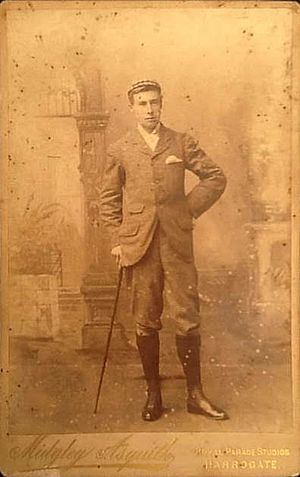Ardlamont murder facts for kids
The Ardlamont Murder (also known as the Ardlamont Mystery or the Monson Case) was a famous event that happened in Argyll, Scotland, on August 10, 1893. It led to two important court cases. One was a murder trial in Edinburgh called HM Advocate v Monson. The other was a case about defamation (saying false things that harm someone's reputation) in London, called Monson v Tussauds Ltd.
Alfred John Monson was on trial for the murder of Cecil Hambrough. He received a special Scottish verdict of "not proven" in his trial at the High Court of Justiciary. This means the jury didn't find him guilty, but they also didn't find him innocent. Later, in 1894, Monson sued Madame Tussauds because they made a wax figure of him that he felt was unfair. He won the case but was only given one farthing in damages. A farthing was the smallest amount of money at that time. This case helped create the idea of "libel by innuendo" in English law. This means you can be sued for defamation even if you don't say something directly, but you hint at it. The Monson v Tussauds Ltd case has been used to help create defamation laws in many countries since then.
This case was very well-known at the time. It became famous again when people realized that Joseph Bell was involved. He was a real-life doctor who inspired the popular fictional detective, Sherlock Holmes. Dr. Bell was called as an expert witness during the murder trial. Another person who inspired Sherlock Holmes, Dr. Henry Littlejohn, also worked on the case. He was a medical expert for the Crown.
Contents
Who Was Involved?
Alfred John Monson
Alfred John Monson was born in 1860. He was the son of Reverend Thomas John Monson. In 1881, he married Agnes Maude Day.
Windsor Dudley Cecil Hambrough
Windsor Dudley Cecil Hambrough was born in 1873. He was part of the Hambrough family. His family lived at Pipewell Hall and Steephill.
Monson started working as a private teacher for the Hambrough family in 1891. In 1893, he rented the Ardlamont estate in Argyll for the hunting season. Windsor Dudley Cecil Hambrough, who was 20 years old, joined him there. Windsor had been living with Monson, his wife, and their three children for his education.
On August 10, Monson took Hambrough hunting in a wooded area. A third man, Edward Scott, joined them. Scott was a friend of Monson. Estate workers heard a gunshot. Then, they saw Monson and Scott running back to Ardlamont House. They were carrying the guns. When the estate butler asked about Mr. Hambrough, Monson said he had accidentally hurt himself while climbing.
The Investigation and Trial
After the incident, someone from the Inveraray procurator fiscal's office (like a public prosecutor) came to the estate. He first said it seemed like a sad accident. There was no official autopsy at that time.
However, two weeks later, Monson went to the fiscal's office. He reported that Hambrough had taken out two life insurance policies. These policies were worth £20,000. This happened only six days before he died. The policies were made out in Monson’s wife's name. Arthur Sebright, a friend of Monson, had helped with these policies. He was a broker who dealt with insurance. After a full search of the estate and interviews with staff, Monson was charged with murder. Scott, who had run away, was named as his helper.
Hambrough was buried in the churchyard at St Catherine's Church, Ventnor. This church was close to his family's home.
Libel by Innuendo Explained
In 1894, Madame Tussauds in London put up a wax figure of Monson. It was placed at the entrance to their Chamber of Horrors. The figure was holding a gun. Monson felt this was unfair and sued the company. He won the case and was awarded one farthing in damages.
This case, Monson v Tussauds, created the legal idea of "libel by innuendo." Libel means publishing something false that harms someone's reputation. "By innuendo" means that even if you don't say something directly, but you hint at it, it can still be considered libel. To prove libel, the false information must be published in a lasting form. This doesn't always have to be in words. This legal principle has been used to help create defamation laws in many countries since then.
Television Show
BBC Scotland Television made a TV show based on this case in 1984. It was called Murder Not Proven: Open Season. The script was written by Peter May, who later became a famous novelist.
Images for kids



